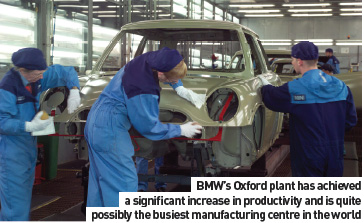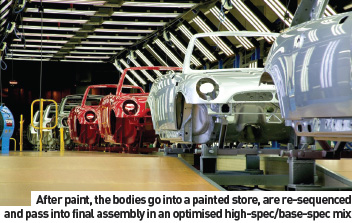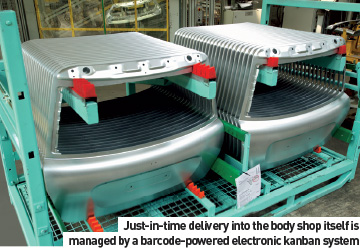.jpg)
BMW’s Plant Oxford is a benchmark for getting the most out of what you’ve got. AMS reports on a prosperous production strategy for the MINI
In a rare example of consensus, the automotive industry seems to have decided that the global economy is a good thing. Everyone agrees that multi-nationalism is the answer, and what is very interesting is seeing the world’s most powerful and dynamic manufacturers casting around, trying to work out what the question was. Because, while everyone wants their piece of this global economy, there isn’t any sign of a universally accepted method of getting it.
For some manufacturers, globalisation means relocating production to zones of low-cost labour; for others, international alliances are the way forward. Some develop models targeted to specific regions; others decide to sell exactly the same products in every market. The more confused try to do all of these things at the same time.
 It is against this background that BMW manages to serenely steer its own course with a global manufacturing policy complex in operation but astoundingly straightforward in aim: the BMW Group concentrates its manufacturing operations close to its biggest market. Working in this way BMW scores plenty of PR points in important markets, but more importantly, it shields itself from the vagaries of international fiscal policies; regardless of the relative state of the Euro, Dollar or Chinese Renminbi, BMW has its bets hedged.
It is against this background that BMW manages to serenely steer its own course with a global manufacturing policy complex in operation but astoundingly straightforward in aim: the BMW Group concentrates its manufacturing operations close to its biggest market. Working in this way BMW scores plenty of PR points in important markets, but more importantly, it shields itself from the vagaries of international fiscal policies; regardless of the relative state of the Euro, Dollar or Chinese Renminbi, BMW has its bets hedged.
Following this logic, BMW takes account of its strong domestic market, so German and Austrian operations account for the bulk of production. The US is an enormous market, so it warrants its own plant at Spartanburg. China is the next big thing and so, in collusion with China Brilliance, it is the latest country to host a BMW vehicle assembly operation. The other world market that BMW holds in high esteem is the UK, where the market for BMW is similar in size to that of Germany. In 2006 it accounted for 155,000 sales. Correspondingly, the UK is the major hub for BMW production, notably the centre for four-cylinder engine production at Hams Hall, Birmingham, the Rolls-Royce factory in distinctly bucolic surroundings of Chichester on England’s southern coast and, of course, BMW Plant Oxford, home of the Mini.
Mini isn’t the world’s best selling car and Oxford isn’t its most productive manufacturing plant – but absolutes aren’t everything. Mini has a good case for arguing it is the most successful selling car in the world, and Oxford is quite possibly the busiest manufacturing centre. Claims such as these can be justified by a quick look at Mini’s order book.
 Very much in the BMW style, Mini was launched as a premium product commanding a premium price.
Very much in the BMW style, Mini was launched as a premium product commanding a premium price.
It had annual sales targets of around 100,000 units, small in the context of the enormous supermini market and, as it transpired, a massive underestimation of Mini’s appeal.
Demand outstripped manufacturing capacity: by 2005 sales were pushing the 200,000 mark. Historically BMW have been happy to keep supply just behind demand, thus justifying price premiums and ensuring bullet-proof residuals, however Mini’s demand was so far in advance of supply, the carmaker wasn’t fully able to capitalise on what it had. To bridge the gap Oxford required a significant increase in productivity – and the key to making it all work is flexibility.
“Actually, Mini production is powered by three different kinds of kinds of flexibility,” says Plant Oxford Deputy Managing Director Paul Chantry. The first and most important is customer orientation: if you multiply the derivatives, the options and colours that we offer 15 thousand trillion (15x1016) different versions, so its highly unlikely that we will ever build the same car twice. We’ve developed our manufacturing system around supplying that level of choice, with the customer able to change the specification as late as seven days before the car is built. The plant has to function properly with this level of customer-driven sequencing – basically what it means is that we have to manage a very complicated build programme and still deliver the car to a required deliver date.”
This segues neatly into the second pillar of Oxford’s flexibility: build order. In theory the plant will build directly to order. In practice, however, the throughput requirements ensure that the plant consolidates its daily build operation into a logical sequence. The choke point is the paintshop. Oxford will build random body-in-white variants to minimise the number of colour changes required in paint. After paint, the bodies go into a painted store, are re-sequenced and pass into final assembly in an optimised high-spec/base-spec mix.
This is pretty standard automotive practice, however, the Mini operation comes into its own with volume flexibility. “In the short and medium term, this is all about flexible workingtime models,” says Chantry. “In agreement with our trades unions we operate a very flexible shift pattern system called ‘The Gearbox’ in which we can rapidly change our hours. We started with a single shift (gear one) and are now up to a threeand- a-half shift pattern. In addition, we have our working time account, under which associates can ‘bank’ hours during busy periods, to be taken as vacation time later. Together it gives us an adaptable approach to volume. We don’t change the line speed very often so our flexibility comes from our working time practices. It is one of the main forces behind our ability to respond to customer demand.”
The system isn’t unique to Oxford, rather it is an intimate part of BMW’s global KOVP production plan, the acronym a contraction of Kundenorientierter Vertriebs und Produktionsprozess (Customer Oriented Sales and Product Process). KOVP has served BMW extremely well. It does, however, place the plant under a greater strain than is evident in other organisations. In the case on Mini, the production line is running 146 hours a week.
“One of the key skills is learning how to deal with your downtime,” continues Chantry. “Common tasks such as maintenance, housekeeping and engineering work have to be thought through very carefully. We discovered how to compress those activities into the only window we have in the regular week, when we shut down from 7pm on a Saturday until 5pm on a Sunday. When we’ve introduced new production equipment for the new model into the existing system our planning needed to be very precise. We managed by the minute rather than by the week, to get everything done.”
The working time model essentially decouples the production staff from the shift system. The factor retains a standard 37-hour working week, though shift patterns vary ensure sensible hours: for example anyone working the night shift will only do three shifts per week. It has made Oxford a more productive plant, but only accounts for approximately two-thirds of the increase in output. The rest is the result of a continuous improvement.
“In the bodyshop, for example, we’ve achieved a 70 per cent improvement in units per hour over the past five years without significant capital investment, simply by optimising and the refining the process,” explains Chantry. “We’ve matched cycle times, studied the material flow until we fully understand it.
We’ve studied robotic motion and taken waste out of that system. For example, in the past a body shop robot would address the part, close its weld tips and carry out its operation. After a review we have changed that so the robot closes its weld tips before arriving at the job. It saves a fraction of a second on every job – but multiply that by four thousand weld spots and the volume has increased a little.
“The continuous improvement philosophy has been vital. We don’t just take what we’ve got and live with it. We’ve had to be a much more pro-active and creative manufacturing unit to get that extra volume out, drive by the imperative of continuing demand for the car. In some years we have been required to increase productivity every month because of pressure of sales, which maybe made us more inventive in our approach to manufacturing that perhaps we would have been otherwise; certainly more than we have been in the past.”
With buoyant sales, BMW had no particular need to launch a second generation Mini, but the company has shown great faith in the idea of Mini as a brand rather than a standalone model.
That demands a constant turnover of product, hence the recent introduction of a second generation. The average customer will be hard pressed to spot the differences from the outside but the interior is a different story: more space, improved comfort, better ergonomics; though even here the changes are mild and obviously from the ‘if it ain’t broke, don’t fix it’ school of car design; the real differences for Mini are under the skin.
 At the time of writing, BMW still hasn’t formally confirmed that the new range will feature a PSA diesel engine, replacing the previous Toyota unit. It has been long acknowledged, however, that following the end of its relationship with the Curitiban Tritec, Mini will source its petrol engines from the BMW Hams Hall engine plant, using normally aspirated and supercharged derivatives of the 4-cylinder engine found on budget BMWs.
At the time of writing, BMW still hasn’t formally confirmed that the new range will feature a PSA diesel engine, replacing the previous Toyota unit. It has been long acknowledged, however, that following the end of its relationship with the Curitiban Tritec, Mini will source its petrol engines from the BMW Hams Hall engine plant, using normally aspirated and supercharged derivatives of the 4-cylinder engine found on budget BMWs.
Added to this is the decision to consolidate pressings operations at BMW Plant Swindon, 50km to the west; suddenly the new Mini has much shorter logistics chains.
“We call it the Mini production triangle and the idea was to treat Oxford, Swindon and Hams Hall as one big factory – albeit one located on three sites,” says Chantry. “We’ve synchronised the operation so that we are all working to the same shift patterns with Swindon and Hams Hall delivering just-in-time and in-sequence respectively. Previously, we received engines from South America and pressings from all over Europe, so the advantages are obvious: it costs us less; the environmental footprint is diminished; customers have greater flexibility to change their orders; and we have been able to remove stores and have more items delivered direct to the line.”
While engine and pressing production has moved closer to the assembly facility, Oxford has concurrently extended the radius from which it can procure other in-sequence parts. It has achieved this by changing the ordering sequence, allocating customer orders at the beginning of the body-in-white process rather than sending a sequence delivery request from the painted body store. Just-in-time delivery into the body shop itself is managed by a barcode-powered electronic kanban system.
The new, streamlined, production process at Plant Oxford has come about through a £100m ($195m) restructuring investment that has been spent over the last 18 months. BMW’s reasoning for the expenditure was two-fold: preparation for the new model and a decision to increase overall capacity by 20 per cent. “In 2005 we hit the absolute peak of what our plant could achieve. We made 200,000 cars and there really wasn’t any further to take it without having a detrimental effect on the plant. At the same time we were aware that the new model would created an increased and sustained demand, and so the decision was taken to increase the capacity of the plant to 240,000. We extended our body-in-white facility and also improved our paintshop with a second top-coat line and a system called the Integrated Paint Process which eliminates one stoving stage.”
When the BMW Mini originally launched it was went through several recalls, questioning the ability of the Oxford plant – and BMW – to maintain the brand. There were mitigating circumstances, not least of which was nasty Rover- BMW divorce which saw the Rover 75 and Mini effectively swap lines: the 75 moving out of Cowley and the Mini moving in. Disruptions of this sort have sank cars in the past and it is a testament to skills of the management and workforce at the renamed BMW Plant Oxford that the Mini weathered the initial storm, took control of its quality and built the brand, while all of the time ramping up productivity. That firm foundation has allowed the brand to prosper and expand and it will not stop there: the concepts BMW has shown for the introduction of a station wagon have been well received by the public and the brand seems set to grow again – and Plant Oxford will grow with it.


































